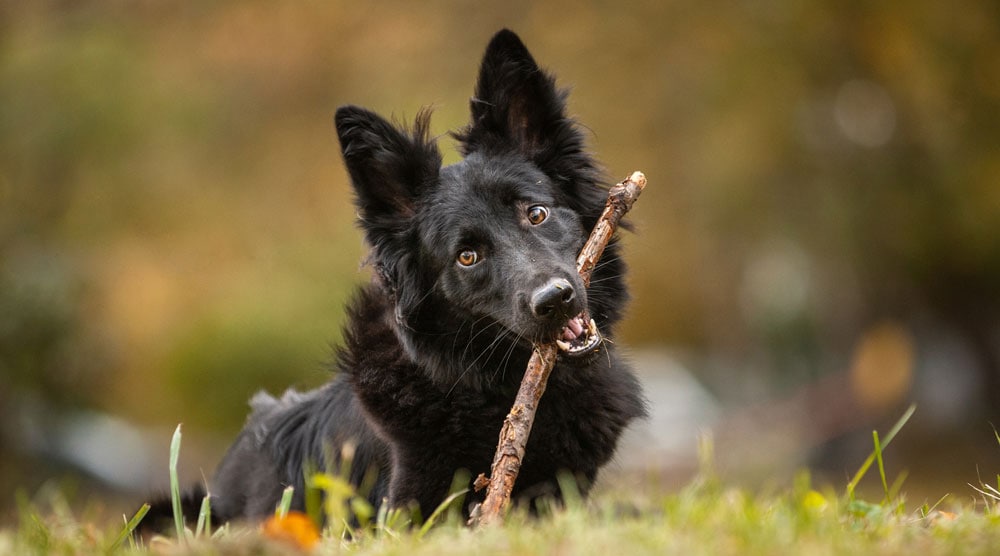A dog bounding through a field holding a stick is a classic image we’re all familiar with. But is it actually safe for dogs to chase or chew sticks?
Unfortunately not! Sticks can be very dangerous to our canine companions for a variety of reasons.
For example, a chewed stick can splinter and cause serious injury to a dog, including mouth wounds and even perforated intestines. Carrying or chasing a stick is also dangerous, as sticks bounce in unpredictable ways and can impale your pet.
In this article, we’ll discuss why you shouldn’t let your dog chew sticks. We’ll also give tips for preventing dogs from playing with sticks and safe alternatives.
Contents
Why Do Dogs Chew Sticks?

Sticks might not seem interesting to us humans, but in the canine behaviour world they are known as multi-sensory objects.
A multi-sensory object is anything that stimulates more than one of a dog’s senses. These objects are often highly appealing to our canine companions, who are always looking for something fun to chew.
In the case of sticks, they each have a unique taste, intriguing scent, and an interesting texture. Many dogs also love the sensation of chewing something that gradually comes apart – although that’s one reason why sticks are dangerous (more on that in a moment).
Chewing a hard object is also stress relieving for dogs. The act of chewing releases feel-good hormones in the brain, such as dopamine and serotonin. Chewing can also relieve tooth or gum pain, especially in puppies going through the teething stage.
Unfortunately, just because dogs enjoy chewing sticks doesn’t mean it’s safe. After all, dogs don’t always make sensible decisions regarding their health!

What Is Pica?
Pica is a medical condition that causes a dog to eat inedible objects like sticks or socks. It’s sometimes caused by a nutritional deficiency in dogs fed an incomplete diet, although it can also be a behavioural issue.
Dogs with pica are at risk of serious health issues, because they might eat something toxic or that blocks the intestines. You should always contact a vet if you suspect your dog is suffering from pica.
The Dangers of a Dog Chewing Sticks
You shouldn’t let your dog chew sticks. There are many risks associated with this behaviour, including:
- Splinters can break off and cause damage to the gums, tongue, or other soft tissues in the mouth.
- The splinters can also get wedged between teeth or stuck in the roof of the mouth. They may then start to rot and cause infections.
- If splinters are swallowed, they can cause damage to the stomach and perforations in the intestine. A perforated intestine allows bacteria to enter the abdomen, which can lead to life-threatening infections.
- Larger bits of a stick can be a serious choking hazard if they get stuck in your dog’s throat. They can also cause intestinal blockages.
- Sticks are hard and cause the teeth to wear down over time. The dog will suffer from toothache if the inner tooth cavity becomes exposed.
- Sticks can fracture a tooth if they chew on a stick too hard, which causes intense pain.
As you can tell, these are serious health risks to your dog. They are all likely to need emergency veterinary treatment – and can even be life-threatening.
Another danger is that some types of wood are toxic to dogs. Red maple, yew, and black walnut are a few examples, but there are many more. There’s also a chance that the stick is covered in toxic pesticides, moulds, or other dangerous substances.

Watch Out For Splinters In the Mouth
It’s not always easy to notice splinters in a dog’s mouth, so you’ll need to watch your dog for signs that something is wrong. These can include pawing at the mouth, a loss of appetite, not drinking as much, whimpering, or other changes in behaviour.
Take your dog to the vet immediately if you notice any signs of illness or if you can see a piece of stick lodged in your dog’s mouth. Removing a splinter yourself is often unsafe, as this could cause severe bleeding.
How to Stop Your Dog Chewing Sticks
Chewing sticks might be dangerous, but dogs don’t realise that! It’s up to us to keep them safe and reduce the chance of injury.
The best way to stop your dog from chewing these hazardous objects is to limit their access to sticks. This means not letting your pet bring sticks into the house and removing them from your yard.
If your pet is a compulsive stick chewer, you might need to avoid walking in woodland. It’s almost impossible to stop your dog from finding sticks to chew in a wooded environment. Instead, parks or open fields are a safer choice.
You should also provide plenty of safe alternatives to sticks. Antler horns, flavoured chew toys, Kongs, and other dog toys can provide a multi-sensory effect without the danger of sticks.
What if your dog loves sticks though? The good news is that there are certain types of wood that are safe for dogs to chew!
For example, some companies sell coffee tree wood sticks for dogs. These are firmer than regular sticks and don’t splinter. Instead, they come apart in soft fibres that are safe to swallow. These products are also treated to ensure they aren’t covered in substances that might be toxic to dogs.
Note: We don’t recommend coffee wood chews if your dog is compulsively driven to chew sticks. While they are safe, these chews can reinforce the habit of chewing sticks and make it more likely for your dog to do so in the future.
Why You Should Never Throw a Stick For Your Dog to Fetch
Sticks are very dangerous if thrown for your dog to fetch. Never throw sticks for your dog, even if you’re trying to be careful, as an accident could happen at any time.
What makes sticks so dangerous though?
Firstly, sticks all have a unique shape and bounce unpredictably. If the stick gets stuck in the ground, it can easily wound or impale your dog as they run towards it at speed.
These wounds are sometimes minor, but there’s a chance that your dog could be seriously injured. For example, it’s not unheard of for the stick to go through the neck into the back of the dog’s mouth. The stick can even become lodged there, as happened in this unfortunate case, leading to severe complications and even death.
There are other ways that playing fetch with a stick can be dangerous. When the dog brings the stick back, they could trip or hit it against a tree, leading to mouth injuries. Chasing the stick through undergrowth can also cause injury to the eyes or face, due to thorns, branches, and other sharp objects.
Even small sticks can be dangerous. It’s not unusual for vets to find them lodged in the dog’s mouth, with the owner only noticing when the stick starts to rot and become infected. As we mentioned earlier, this often requires surgery, as pulling out the stick could cause severe bleeding.
The bottom line is that you can’t expect your dog to be sensible when chasing a stick, which makes it a dangerous activity. They will be excited about the game and won’t be thinking about safety. Dogs also have poor spatial awareness for objects they carry.
To keep your dog safe, use dog toys such as rubber frisbees, balls that are big enough not to be a choking hazard, and rope toys. Only throw them in open areas, so your dog doesn’t hurtle through the undergrowth into potential danger.
Important: Don’t pull out sticks or other objects caught in the roof of your dog’s mouth or back of their throat. Take them immediately to a vet, as removing the object could be risky without proper care.
Summary
Sticks can be surprisingly dangerous for our canine companions to chew or play with.
Chewing a stick can cause mouth wounds, intestinal damage, and choking. And games of fetch with a stick can lead to nasty injuries, such as the dog being impaled through the throat.
For these reasons, you shouldn’t let your dog have sticks. Instead, replace them with dog toys that are safe and enjoyable to chew.
